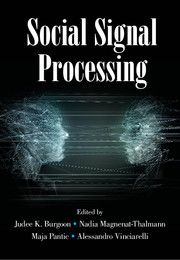Book contents
- Frontmatter
- Contents
- Contributors
- 1 Introduction: Social Signal Processing
- Part I Conceptual Models of Social Signals
- Part II Machine Analysis of Social Signals
- 11 Facial Actions as Social Signals
- 12 Automatic Analysis of Bodily Social Signals
- 13 Computational Approaches for Personality Prediction
- 14 Automatic Analysis of Aesthetics: Human Beauty, Attractiveness, and Likability
- 15 Interpersonal Synchrony: From Social Perception to Social Interaction
- 16 Automatic Analysis of Social Emotions
- 17 Social Signal Processing for Automatic Role Recognition
- 18 Machine Learning Methods for Social Signal Processing
- Part III Machine Synthesis of Social Signals
- Part IV Applications of Social Signal Processing
- References
11 - Facial Actions as Social Signals
from Part II - Machine Analysis of Social Signals
Published online by Cambridge University Press: 13 July 2017
- Frontmatter
- Contents
- Contributors
- 1 Introduction: Social Signal Processing
- Part I Conceptual Models of Social Signals
- Part II Machine Analysis of Social Signals
- 11 Facial Actions as Social Signals
- 12 Automatic Analysis of Bodily Social Signals
- 13 Computational Approaches for Personality Prediction
- 14 Automatic Analysis of Aesthetics: Human Beauty, Attractiveness, and Likability
- 15 Interpersonal Synchrony: From Social Perception to Social Interaction
- 16 Automatic Analysis of Social Emotions
- 17 Social Signal Processing for Automatic Role Recognition
- 18 Machine Learning Methods for Social Signal Processing
- Part III Machine Synthesis of Social Signals
- Part IV Applications of Social Signal Processing
- References
Summary
According to a recent survey on social signal processing (Vinciarelli, Pantic, & Bourlard, 2009), next-generation computing needs to implement the essence of social intelligence including the ability to recognize human social signals and social behaviors, such as turn taking, politeness, and disagreement, in order to become more effective and more efficient. Social signals and social behaviors are the expression of one's attitude towards social situation and interplay, and they are manifested through a multiplicity of nonverbal behavioral cues, including facial expressions, body postures and gestures, and vocal outbursts like laughter. Of the many social signals, only face, eye, and posture cues are capable of informing us about all identified social behaviors. During social interaction, it is a social norm that one looks their dyadic partner in the eyes, clearly focusing one's vision on the face. Facial expressions thus make for very powerful social signals. As one of the most comprehensive and objective ways to describe facial expressions, the facial action coding system (FACS) has recently received significant attention. Automating FACS coding would greatly benefit social signal processing, opening up new avenues to understanding how we communicate through facial expressions. In this chapter we provide a comprehensive overview of research into machine analysis of facial actions. We systematically review all components of such systems: pre-processing, feature extraction, and machine coding of facial actions. In addition, the existing FACS-coded facial expression databases are summarized. Finally, challenges that have to be addressed to make automatic facial action analysis applicable in real-life situations are extensively discussed.
Introduction
Scientific work on facial expressions can be traced back to at least 1872 when Charles Darwin published The Expression of the Emotions in Man and Animals (1872). He explored the importance of facial expressions for communication and described variations in facial expressions of emotions. Today, it is widely acknowledged that facial expressions serve as the primary nonverbal social signal for human beings, and are responsible for a large part to regulate interactions with each other (Ekman & Ronsenberg, 2005). They communicate emotions, clarify and emphasize what is being said, and signal comprehension, disagreement, and intentions (Pantic, 2009).
- Type
- Chapter
- Information
- Social Signal Processing , pp. 123 - 154Publisher: Cambridge University PressPrint publication year: 2017
References
- 4
- Cited by



